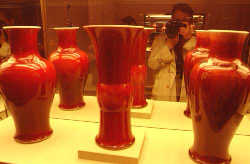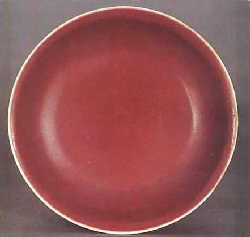 Porcelain fit only for royalty
Porcelain fit only for royalty
Successive emperors also demanded expensive Jihong porcelain, but as the legend suggests, it was very hard to produce. Among the ten thousand plus items inJingdezhen Ceramics Museum, there are only ten Jihong porcelain objects, one of which is only half of its original size and there are less than one hundred Jihong porcelain objects in museums worldwide.
Generations of Jingdezhen people endeavored to produce the porcelain in the following hundreds of years, but Jihong porcelain was never successfully reproduced. From the Ming Dynasty when Jihong porcelain was first produced, generations of Jingdezhen porcelain craftsmen have made numerous attempts to manufacture Jihong, but the results have not been as good.
The imperial kiln's only customer was the court, and it had very high product quality standards. The porcelain made in these kilns underwent a strict selection process. Works which didn't make the grade, were broken and buried because common people were forbidden to use them.
In 1982, an ancient imperial kiln with many pieces of red under glaze porcelain was accidentally found. Archeologists found many of the pieces could be glued together to make complete items. It seemed that these pieces were destroyed intentionally. Closer examination showed no obvious defects, some pieces were extremely skilled and still lustrous even after hundreds of years.
 The revival of Jihong porcelain making
The revival of Jihong porcelain making
 Western scholars examined the chemical ingredients of Jihong porcelain in the 19th century, but their attempt to reproduce similar porcelain with red under glaze failed.
Western scholars examined the chemical ingredients of Jihong porcelain in the 19th century, but their attempt to reproduce similar porcelain with red under glaze failed.
In the 1950s, Jingdezhen established a center to produce colored under glaze, summoning seasoned craftsmen to research the firing techniques for various high-quality porcelains including Jihong.
Although there has been a porcelain industry in Jingdezhen for thousands of years, the red under glaze formula has always been a secret, passed down only within families. Luck and experience also played important roles in producing rare works like Jihong porcelain.
After persistent testing, researchers finally made some refined Jihong works that are just as beautiful as those from theQing Dynasty. They were made with traditional kilns, and 35 tons of wood were burned to produce them.
